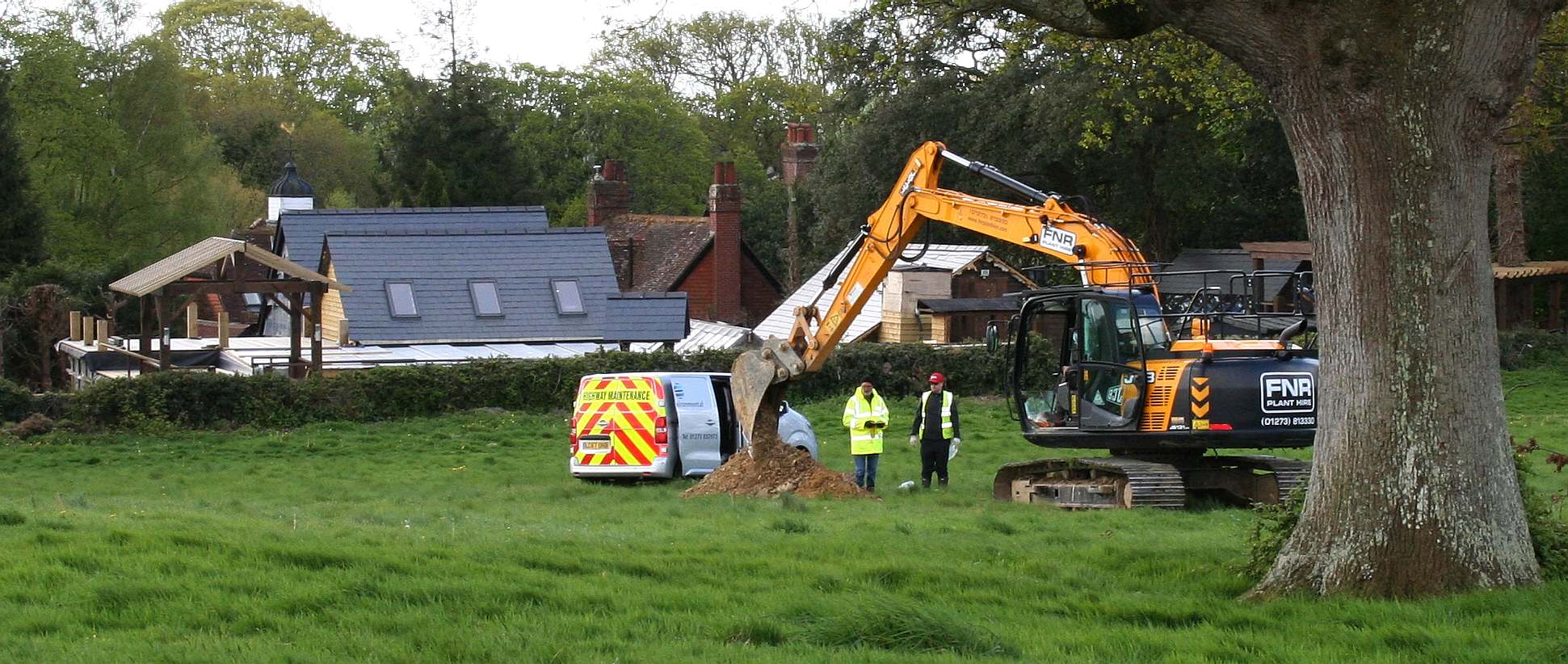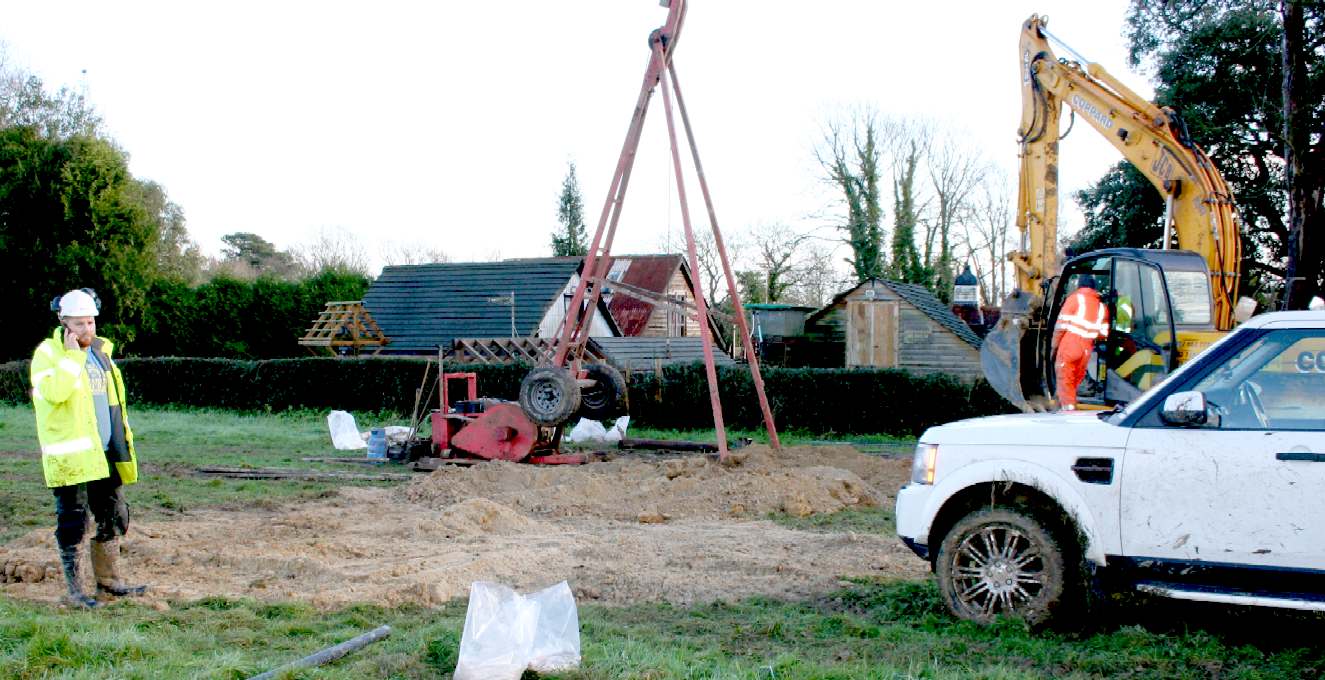|

WATER
RIGHTS - Clarion Housing Group and Thakeham
Homes are in danger of spoiling an ancient well that supplies water
to many concerns in this vicinity. In the picture you can see a hired
digger scooping out trenches to test drainage by pouring in water and
measuring the rate of absorption by the soil. It seems to us that if you
build houses on the ground that feeds the ancient well, that
contamination from garden treatments such as Roundup and engine oils,
etc., will find its way into this well leading to claims against the
owners of the houses who would have been sold a pup, and/or against the
Council for approving the proposal, by way of a negligence claim, and/or
against the vendors or developers. Any way you look at it the developers
and Council concerned should take steps to ensure that no development
takes place until the proper tests and evaluations have been completed,
and after that stage, to ensure that any houses built in this location
will not be on a path that includes the water
table that feeds the ancient well.
Any
failure to conduct the proper tests and house situation, along with safe
sewage disposal, may tempt the Secretary
of State to call in the application. We imagine that all of those
with a financial interest in this piece of greenbelt will want to
resolve issues before it starts to get complicated.
PLAN
MAKING
Local Plans
150. Local Plans are the key to delivering sustainable development that reflects the
vision and aspirations of local communities. Planning decisions must be taken
in accordance with the development plan unless material considerations
indicate otherwise.
151. Local Plans must be prepared with the objective of contributing to the
achievement of sustainable development. To this end, they should be
consistent with the principles and policies set out in this Framework,
including the presumption in favour of sustainable development.
152. Local planning authorities should seek opportunities to achieve each of the
economic, social and environmental dimensions of sustainable development,
and net gains across all three. Significant adverse impacts on any of these
dimensions should be avoided and, wherever possible, alternative options
which reduce or eliminate such impacts should be pursued. Where adverse
impacts are unavoidable, measures to mitigate the impact should be
considered. Where adequate mitigation measures are not possible,
compensatory measures may be appropriate.
153. Each local planning authority should produce a Local Plan for its area.
This can be reviewed in whole or in part to respond flexibly to changing
circumstances. Any additional development plan documents should only be
used where clearly justified. Supplementary planning documents should be
used where they can help applicants make successful applications or aid
infrastructure delivery, and should not be used to add unnecessarily to the
financial burdens on development.
154. Local Plans should be aspirational but realistic. They should address the
spatial implications of economic, social and environmental change. Local
Plans should set out the opportunities for development and clear policies on
what will or will not be permitted and where. Only policies that provide a
clear indication of how a decision maker should react to a development
proposal should be included in the plan.
155. Early and meaningful engagement and collaboration with neighbourhoods,
local organisations and businesses is essential. A wide section of the
community should be proactively engaged, so that Local Plans, as far as
possible, reflect a collective vision and a set of agreed priorities for the
sustainable development of the area, including those contained in any
neighbourhood plans that have been made.
156. Local planning authorities should set out the strategic priorities for the area
in the Local Plan. This should include strategic policies to deliver:
●● the homes and jobs needed in the area;
●● the provision of retail, leisure and other commercial development;
●● the provision of infrastructure for transport, telecommunications, waste
management, water supply, wastewater, flood risk and coastal change
management, and the provision of minerals and energy (including heat);
●● the provision of health, security, community and cultural infrastructure and
other local facilities; and
●● climate change mitigation and adaptation, conservation and enhancement
of the natural and historic environment, including landscape.
157. Crucially, Local Plans should:
●● plan positively for the development and infrastructure required in the area
to meet the objectives, principles and policies of this Framework;
●● be drawn up over an appropriate time scale, preferably a 15-year time
horizon, take account of longer term requirements, and be kept up to
date;
●● be based on co-operation with neighbouring authorities, public, voluntary
and private sector organisations;
●● indicate broad locations for strategic development on a key diagram and
land-use designations on a proposals map;
●● allocate sites to promote development and flexible use of land, bringing
forward new land where necessary, and provide detail on form, scale,
access and quantum of development where appropriate;
●● identify areas where it may be necessary to limit freedom to change the
uses of buildings, and support such restrictions with a clear explanation;
●● identify land where development would be inappropriate, for instance
because of its environmental or historic significance; and
●● contain a clear strategy for enhancing the natural, built and historic
environment, and supporting Nature Improvement Areas where they have
been identified.
Using a proportionate evidence base
158. Each local planning authority should ensure that the Local Plan is based on
adequate, up-to-date and relevant evidence about the economic, social and
environmental characteristics and prospects of the area. Local planning
authorities should ensure that their assessment of and strategies for housing,
employment and other uses are integrated, and that they take full account of
relevant market and economic signals.
Housing
159. Local planning authorities should have a clear understanding of housing
needs in their area. They should:
●● prepare a Strategic Housing Market Assessment to assess their full housing
needs, working with neighbouring authorities where housing market areas
cross administrative boundaries. The Strategic Housing Market Assessment
should identify the scale and mix of housing and the range of tenures that
the local population is likely to need over the plan period which:
–– meets household and population projections, taking account of
migration and demographic change;
–– addresses the need for all types of housing, including affordable
housing and the needs of different groups in the community (such as,
but not limited to, families with children, older people, people with
disabilities, service families and people wishing to build their own
homes); and
–– caters for housing demand and the scale of housing supply necessary to
meet this demand;
●● prepare a Strategic Housing Land Availability Assessment to establish
realistic assumptions about the availability, suitability and the likely
economic viability of land to meet the identified need for housing over the
plan period.
Business
160. Local planning authorities should have a clear understanding of business
needs within the economic markets operating in and across their area. To
achieve this, they should:
●● work together with county and neighbouring authorities and with Local
Enterprise Partnerships to prepare and maintain a robust evidence base to
understand both existing business needs and likely changes in the market;
and
●● work closely with the business community to understand their changing
needs and identify and address barriers to investment, including a lack of
housing, infrastructure or viability.
161. Local planning authorities should use this evidence base to assess:
●● the needs for land or floorspace for economic development, including
both the quantitative and qualitative needs for all foreseeable types of
economic activity over the plan period, including for retail and leisure
development;
●● the existing and future supply of land available for economic development
and its sufficiency and suitability to meet the identified needs. Reviews of
land available for economic development should be undertaken at the
same time as, or combined with, Strategic Housing Land Availability
Assessments and should include a reappraisal of the suitability of
previously allocated land;
●● the role and function of town centres and the relationship between them,
including any trends in the performance of centres;
●● the capacity of existing centres to accommodate new town centre
development;
●● locations of deprivation which may benefit from planned remedial action;
and
34 The planning policy for traveller sites sets out how travellers’ accommodation needs should also
be assessed.
●● the needs of the food production industry and any barriers to investment that
planning can resolve.
Infrastructure
162. Local planning authorities should work with other authorities and providers to:
●● assess the quality and capacity of infrastructure for transport,
water supply,
wastewater and its treatment, energy (including heat), telecommunications,
utilities, waste, health, social care, education, flood risk and coastal change
management, and its ability to meet forecast demands; and
●● take account of the need for strategic infrastructure including nationally significant
infrastructure within their areas.
Minerals
163. Minerals planning authorities should work with other relevant organisations to use
the best available information to:
●● develop and maintain an understanding of the extent and location of mineral
resource in their areas; and
●● assess the projected demand for their use, taking full account of opportunities to
use materials from secondary and other sources which could provide suitable
alternatives to primary materials.
Defence, national security, counter-terrorism and resilience
164. Local planning authorities should:
●● work with the Ministry of Defence’s Strategic Planning Team to ensure that they
have and take into account the most up-to-date information about defence and
security needs in their area; and
●● work with local advisors and others to ensure that they have and take into account
the most up-to-date information about higher risk sites in their area for malicious
threats and natural hazards, including steps that can be taken to reduce
vulnerability and increase resilience.
Environment
165. Planning policies and decisions should be based on up-to-date information about the
natural environment and other characteristics of the area including drawing, for
example, from River Basin Management Plans. Working with Local Nature
Partnerships where appropriate, this should include an assessment of existing and
potential components of ecological networks. A sustainability appraisal which meets
the requirements of the European Directive on strategic environmental assessment
should be an integral part of the plan preparation process, and should consider all the
likely significant effects on the environment, economic and social factors.
166. Local Plans may require a variety of other environmental assessments, including under
the Habitats Regulations where there is a likely significant effect on a European
wildlife site (which may not necessarily be within the same local authority area),
Strategic Flood Risk Assessment and assessments of the physical constraints on land
use. Wherever possible, assessments should share the same evidence base and be
conducted over similar timescales, but local authorities should take care to
ensure that the purposes and statutory requirements of different assessment
processes are respected.
167. Assessments should be proportionate, and should not repeat policy
assessment that has already been undertaken. Wherever possible the local
planning authority should consider how the preparation of any assessment
will contribute to the plan’s evidence base. The process should be started
early in the plan-making process and key stakeholders should be consulted in
identifying the issues that the assessment must cover.
168. Shoreline Management Plans should inform the evidence base for planning in
coastal areas. The prediction of future impacts should include the longer term
nature and inherent uncertainty of coastal processes (including coastal
landslip), and take account of climate change.
Historic environment
169. Local planning authorities should have up-to-date evidence about the historic
environment in their area and use it to assess the significance of heritage
assets and the contribution they make to their environment. They should also
use it to predict the likelihood that currently unidentified heritage assets,
particularly sites of historic and archaeological interest, will be discovered in
the future. Local planning authorities should either maintain or have access
to a historic environment record.
170. Where appropriate, landscape character assessments should also be prepared,
integrated with assessment of historic landscape character, and for areas
where there are major expansion options assessments of landscape sensitivity.
Health and well-being
171. Local planning authorities should work with public health leads and health
organisations to understand and take account of the health status and needs
of the local population (such as for sports, recreation and places of worship),
including expected future changes, and any information about relevant
barriers to improving health and well-being.
Public safety from major accidents
172. Planning policies should be based on up-to-date information on the location of
major hazards and on the mitigation of the consequences of major
accidents.
Ensuring viability and deliverability
173. Pursuing sustainable development requires careful attention to viability and
costs in plan-making and decision-taking. Plans should be deliverable.
Therefore, the sites and the scale of development identified in the plan should
not be subject to such a scale of obligations and policy burdens that their
ability to be developed viably is threatened. To ensure viability, the costs of any
requirements likely to be applied to development, such as requirements for
affordable housing, standards, infrastructure contributions or other
requirements should, when taking account of the normal cost of development
and mitigation, provide competitive returns to a willing land owner and
willing developer to enable the development to be deliverable.
174. Local planning authorities should set out their policy on local standards in the
Local Plan, including requirements for affordable housing. They should assess
the likely cumulative impacts on development in their area of all existing and
proposed local standards, supplementary planning documents and policies
that support the development plan, when added to nationally required
standards. In order to be appropriate, the cumulative impact of these
standards and policies should not put implementation of the plan at serious
risk, and should facilitate development throughout the economic cycle.
Evidence supporting the assessment should be proportionate, using only
appropriate available evidence.
175. Where practical, Community Infrastructure Levy charges should be worked
up and tested alongside the Local Plan. The Community Infrastructure Levy
should support and incentivise new development, particularly by placing
control over a meaningful proportion of the funds raised with the
neighbourhoods where development takes place.
176. Where safeguards are necessary to make a particular development acceptable
in planning terms (such as environmental mitigation or compensation), the
development should not be approved if the measures required cannot be
secured through appropriate conditions or agreements. The need for such
safeguards should be clearly justified through discussions with the applicant,
and the options for keeping such costs to a minimum fully explored, so that
development is not inhibited unnecessarily.
177. It is equally important to ensure that there is a reasonable prospect that
planned infrastructure is deliverable in a timely fashion. To facilitate this, it is
important that local planning authorities understand district-wide
development costs at the time Local Plans are drawn up. For this reason,
infrastructure and development policies should be planned at the same time,
in the Local Plan. Any affordable housing or local standards requirements that
may be applied to development should be assessed at the plan-making stage,
where possible, and kept under review.
Planning strategically across local boundaries
178. Public bodies have a duty to cooperate on planning issues that cross
administrative boundaries, particularly those which relate to the strategic
priorities set out in paragraph 156. The Government expects joint working
on areas of common interest to be diligently undertaken for the mutual
benefit of neighbouring authorities.
179. Local planning authorities should work collaboratively with other bodies to
ensure that strategic priorities across local boundaries are properly coordinated
and clearly reflected in individual Local Plans. Joint working
should enable local planning authorities to work together to meet
development requirements which cannot wholly be met within their own
areas – for instance, because of a lack of physical capacity or because to do
so would cause significant harm to the principles and policies of this
Framework. As part of this process, they should consider producing joint
planning policies on strategic matters and informal strategies such as joint
infrastructure and investment plans.
180. Local planning authorities should take account of different geographic areas,
including travel-to-work areas. In two tier areas, county and district
authorities should cooperate with each other on relevant issues. Local
planning authorities should work collaboratively on strategic planning
priorities to enable delivery of sustainable development in consultation with
Local Enterprise Partnerships and Local Nature Partnerships. Local planning
authorities should also work collaboratively with private sector bodies, utility
and infrastructure providers.
181. Local planning authorities will be expected to demonstrate evidence of
having effectively cooperated to plan for issues with cross-boundary impacts
when their Local Plans are submitted for examination. This could be by way
of plans or policies prepared as part of a joint committee, a memorandum of
understanding or a jointly prepared strategy which is presented as evidence
of an agreed position. Cooperation should be a continuous process of
engagement from initial thinking through to implementation, resulting in a
final position where plans are in place to provide the land and infrastructure
necessary to support current and projected future levels of development.
Examining Local Plans
182. The Local Plan will be examined by an independent inspector whose role is to
assess whether the plan has been prepared in accordance with the Duty to
Cooperate, legal and procedural requirements, and whether it is sound. A
local planning authority should submit a plan for examination which it
considers is “sound” – namely that it is:
●● Positively prepared – the plan should be prepared based on a strategy
which seeks to meet objectively assessed development and infrastructure
requirements, including unmet requirements from neighbouring
authorities where it is reasonable to do so and consistent with achieving
sustainable development;
●● Justified – the plan should be the most appropriate strategy, when
considered against the reasonable alternatives, based on proportionate
evidence;
●● Effective – the plan should be deliverable over its period and based on
effective joint working on cross-boundary strategic priorities; and
●● Consistent with national policy – the plan should enable the delivery of
sustainable development in accordance with the policies in the
Framework.
Neighbourhood plans
183. Neighbourhood planning gives communities direct power to develop
a shared vision for their neighbourhood and deliver the sustainable
development they need. Parishes and neighbourhood forums can use
neighbourhood planning to:
●● set planning policies through neighbourhood plans to determine decisions
on planning applications; and
●● grant planning permission through Neighbourhood Development Orders
and Community Right to Build Orders for specific development which
complies with the order.
184. Neighbourhood planning provides a powerful set of tools for local people
to ensure that they get the right types of development for their community.
The ambition of the neighbourhood should be aligned with the strategic
needs and priorities of the wider local area. Neighbourhood plans must be in
general conformity with the strategic policies of the Local Plan. To facilitate
this, local planning authorities should set out clearly their strategic policies
for the area and ensure that an up-to-date Local Plan is in place as quickly
as possible. Neighbourhood plans should reflect these policies and
neighbourhoods should plan positively to support them. Neighbourhood
plans and orders should not promote less development than set out in the
Local Plan or undermine its strategic policies.
185. Outside these strategic elements, neighbourhood plans will be able to shape
and direct sustainable development in their area. Once a neighbourhood plan
has demonstrated its general conformity with the strategic policies of the Local
Plan and is brought into force, the policies it contains take precedence over
existing non-strategic policies in the Local Plan for that neighbourhood, where
they are in conflict. Local planning authorities should avoid duplicating
planning processes for non-strategic policies where a neighbourhood plan
is in preparation.
CONTACTS
Department for Communities and Local Government
Eland House
Bressenden Place
London,
SW1E 5DU
United
Kingdom
Telephone: 030 3444 0000

HINKLEY,
CALIFORNIA - GROUND WATER CONTAMINATION - The
town of Hinkley, California,
located in the Mojave Desert, (about 121 miles driving distance
north-northeast of Los Angeles) had its groundwater contaminated with
hexavalent chromium starting in 1952, resulting in a legal case
against Pacific Gas & Electric (PG&E) and a multimillion-dollar
settlement in 1996. The legal case was dramatized in the film Erin
Brockovich, released in 2000.
Residents of Hinkley filed a class action against PG&E,
encaptioned Anderson, et al. v. Pacific Gas and Electric (Superior Ct.
for County of San Bernardino, Barstow Division, file BCV 00300.
In 1993, Erin Brockovich, a legal clerk to lawyer Edward L. Masry,
investigated the apparent elevated cluster of illnesses in the
community linked to hexavalent chromium. The efforts of Brockovich and
Masry, and the plight of the people of Hinkley, became widely known
when the film Erin Brockovich was released in 2000.


After
many arguments, the case was referred to arbitration with maximum
damages of $400 million. After the arbitration for the first 40 people
resulted in roughly $110 million,
PG&E reassessed its position and decided to end arbitration and
settle the entire case. The case was settled in 1996 for $333 million,
the largest settlement ever paid in a direct-action lawsuit in U.S.
history.
In 2006, PG&E agreed to pay $295 million to settle cases involving
another 1,100 people statewide for hexavalent chromium-related claims.
In 2008, PG&E
settled the last of the cases involved with the Hinkley claims for $20
million.
LEAD
CASE: In the case of Wealden
District Council and planning application WD/2015/0090/MAO,
originally filed by Tim
Watson in 2014, then re-filed by Gleeson
Developments in 2015, and taken over by Clarion
Group and Thakeham
Group, there appear to be multiple errors in applying these
policies to greenbelt, including failing to protect open spaces and
the historic built environment, and not promoting sustainable
transport.
The
Horse
Sanctuary Trust are following this case with much interest. We
consider that the paper trail will eventually make interesting
reading, leading us to who is making the decisions and the money
........

GREENBELT
- Digging up Greenfield sites for quick
profits from windfall planning consents is ruining the heritage of
the nation. Once it is gone, it is gone. Britain is short of genuinely
affordable housing that developers are loath to provide where all they
want is the money. It may be that Clarion Housing and Thakeham intend
building affordable units on this site. They should also bear in mind
the requirement for sustainable development in United
Nations terms. Copyright photograph © April 26 2018, Herstmonceux
Museum Limited. All rights reserved. You may not copy this picture
except for educational
use.
|




